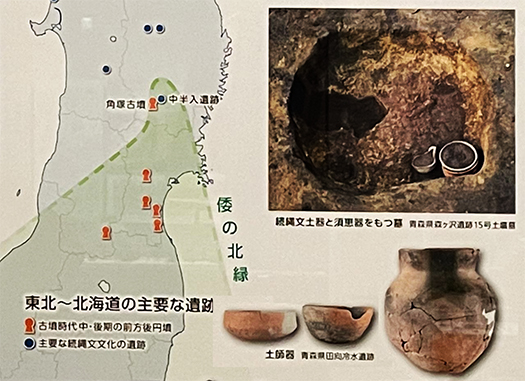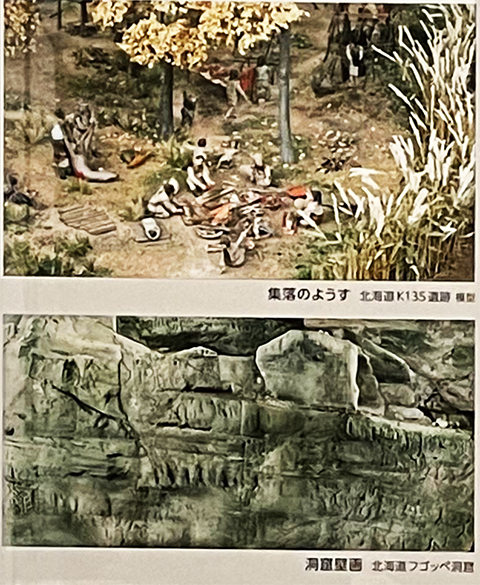

国立歴史民俗博物館の古代史展示の大革新に刺激されるブログシリーズですが、
やはり時系列でときどき触れられている北縁世界、北海道島と東北北部社会に
北海道人としては強く惹かれざるを得ない。
「古墳をつくらない境界世界」というように紹介パネル。
なんですが、わたしは札幌近郊の江別古墳群をよく見ている。
いまは高速ICの江別西を一般道に下りて北上していくと左手の丘陵地帯に
それはある。しかしたしかに始原期の古墳ではなく
やや時代が下った奈良・平安期に造営されたと言われている。
なので、正しくは「つくったけれどかなり遅れた」世界なのだと思う。
この国家始原期の古墳時代には北海道は参加していない。
積雪寒冷という条件から、ごく一部の津軽平野地域を除いて
その生活文化基盤である水田農耕は北海道・東北北部には波及しなかった。
ごく一部の津軽平野部も、その後の十和田の火山噴火被害で一時消滅した。
続縄文といわれるライフスタイルが北海道・北東北では継続した。
しかし一方で仙台平野地域までは古墳時代の痕跡が残る。
仙台市内にも「遠見塚古墳」があり、国道4号線に面している。
やはり水田農耕の北限地域というラインに沿って
境界が区画されて、列島社会は分断されていたということなのでしょう。

この続縄文期の北海道島の様子は地元のことなので
この千葉県の国立歴史民俗博物館展示で見るといかにも懐かしい(笑)。
そうなんですよ、こうやって暮らしていたんですよ、と声を上げたくなる。
縄文的ライフスタイルとしては適地でもあり、
季節毎にカムイの食の恩恵に従順に暮らしを営んでいたと思える。
余市のフゴッペ洞窟には日本海側での北方アジアとの交流痕跡もある。
しかしさらに北のサハリンには北からの中国権力の影響もあって
それと緊張関係も惹起する趨勢になっていくし、さらにオホーツク文化人という
アムール川河口地域から大型海生動物をハンティングしながら
オホーツク沿岸地域に南下定住しはじめた人びととの緊張関係も芽生えた。
時代をやや下ればそうした相克が阿倍比羅夫の武力を利用する事態も勃発する。
決して孤立的にあったのではなく、常に日本社会との連動が続いていた。
・・・って、日本社会から移住してきたわが家系のことも考える自分がある。
移住者の末裔としての自分自身としては強い「故郷」感がふたつある。
環瀬戸内海的な感覚と、北方日本海沿岸的感覚。
こういう独自なシンクロ感覚というのはわたしの世代としては自然。
考えようによってはそういう強い帰属意識をふたつながら持てることで
多様な日本社会という視点でも考えられるのではないかと
最近は「いい方向」で考えるようにしている。
どっちに対しても親近感と理性的判断力を持てるみたいな。妄想ですね(笑)。
English version⬇
Hokkaido Island in the Early Days of the Japanese Nation: The 37,000-Year History of the Japanese Archipelago – 50
The Japanese culture-centered viewpoint and the perspective as an emigrant to Ezo. As a resident of Hokkaido, I want to have an affinity and calm reason for both. …
This blog series is inspired by the great innovation of the National Museum of Japanese History’s ancient history exhibit.
I am still strongly attracted to the northern rim world, Hokkaido Island and northern Tohoku society, which are sometimes mentioned in chronological order.
As a Hokkaider, I cannot help but be strongly attracted to the northern border world, Hokkaido Island and northern Tohoku society, which are mentioned from time to time.
The panel introduces the northern border world as “the border world that does not create ancient tombs.
I have often seen the Ebetsu tumulus group in the suburbs of Sapporo.
Nowadays, when you exit the Ebetsu Nishi highway IC onto the public road and head north, you will find a hillside on your left.
It is located on the hillside to the left. However, it is not a burial mound of the primitive period, but rather a slightly later burial mound
It is said to have been built in the Nara and Heian periods, which is a little later than the original period.
Therefore, I think it is a world that was “created but quite late” to be correct.
Hokkaido did not participate in the Kofun period of the primordial period of the nation.
Except for a few areas in the Tsugaru Plain, Hokkaido did not participate in the Kofun period of the primordial period of the nation.
Paddy field agriculture, the basis of life and culture, did not spread to Hokkaido and the northern Tohoku region.
A small portion of the Tsugaru Plain area was temporarily destroyed by the subsequent volcanic eruption in Towada.
The “Continuation Jomon” lifestyle continued in Hokkaido and the northern Tohoku region.
On the other hand, traces of the Kofun period remain as far as the Sendai Plain area.
In Sendai City, there is the “Tomizuka Tumulus,” which faces National Route 4.
It is still along the line of the northern limit of rice paddy farming.
The boundaries were demarcated along the line of the northern limit of rice paddy farming, and the society of the archipelago was divided.
This Continued Jomon Period on Hokkaido Island is so local.
How nostalgic it is to see it in this National Museum of Japanese History exhibit in Chiba Prefecture (laughs).
It makes me want to shout out, “Yes, this is how we lived.
It’s also an apt place for a Jomon lifestyle.
It seems that they lived their lives obediently to the blessings of Kamui food in every season.
There are traces of interaction with northern Asia on the Sea of Japan side in the Fugoppe Cave in Yoichi.
But further north, in Sakhalin, there is also the influence of Chinese power from the north.
This would have caused tensions between the Chinese and the Okhotsk culture.
While hunting large marine animals from the Amur River estuary area
Tensions also developed with the Okhotsk cultural people, who began settling southward in the coastal areas of Okhotsk while hunting large marine animals from the Amur River estuary region.
Somewhat later in the period, such conflicts led to the use of military force by the Abenohiras.
The Abenohiras were never isolated from the rest of Japanese society, but were always linked to it.
I think of myself as a descendant of emigrants from the Japanese society.
As a descendant of immigrants, I have two strong senses of “home.
One is a sense of the Inland Sea Rim, and the other is a sense of the northern Sea of Japan coast.
This unique sense of synchronization is natural for my generation.
Depending on how you look at it, having two such strong senses of belonging
I think that by having these two strong senses of belonging, we can also think from the perspective of a diverse Japanese society.
I try to think in a “positive” direction these days.
I can have a sense of closeness and rational judgment toward both sides. It’s a delusion (laughs).
Posted on 12月 23rd, 2022 by 三木 奎吾
Filed under: 日本社会・文化研究, 歴史探訪







コメントを投稿
「※誹謗中傷や、悪意のある書き込み、営利目的などのコメントを防ぐために、投稿された全てのコメントは一時的に保留されますのでご了承ください。」
You must be logged in to post a comment.